Sculpt Bevel: Δημιουργήστε το φάλτσο κατά μήκος της καμπύλης.
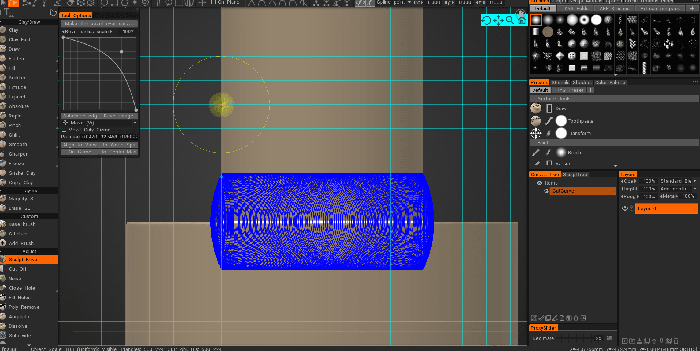
Αρχικά, πρέπει να τοποθετήσετε την καμπύλη (ή πολλές καμπύλες) γύρω από τις άκρες όπου πρέπει να τοποθετήσετε τη λοξότμηση. Προσαρμόστε την ακτίνα της πένας για να ορίσετε την ακτίνα λοξότμησης. Η ακτίνα λοξοτομής μπορεί να διαφέρει από σημείο σε σημείο. Μπορείτε να κλιμακώσετε ολόκληρη την ακτίνα λοξότμησης αργότερα χρησιμοποιώντας το ρυθμιστικό “Κλίμακα ακτίνας λοξότμησης”. Προσαρμόστε το λοξότμητο σχήμα στο παράθυρο εάν χρειάζεται. Επιλέξτε τις καμπύλες και πατήστε το κουμπί “Make bevel over curves”. Η λοξότμηση θα δημιουργηθεί γύρω από τις επιλεγμένες καμπύλες.
– Κάθε σημείο καμπύλης μπορεί να έχει την ακτίνα του, που ορίζεται όταν κάνετε κλικ για να προσθέσετε ένα σημείο στην καμπύλη. αυτή η ακτίνα θα χρησιμοποιηθεί για την λοξότμηση.
– Εάν δεν έχει επιλεγεί καμία από τις καμπύλες, όλες οι ορατές καμπύλες θα χρησιμοποιηθούν για τη λοξότμηση.
– Εάν το επίπεδο της λεπτομέρειας δεν είναι αρκετό, πατήστε Αναίρεση και μετά «Υποδιαίρεση άκρης» και μετά κάντε ξανά τη λοξότμηση.
– Το Bevel δημιουργείται πάνω από τον τρέχοντα τόμο, επομένως επιλέξτε τον σωστό τρέχοντα τόμο.
– Το λοξότμητο δεν αλλάζει την πυκνότητα/τοπολογία, επομένως είναι απλώς η παραμόρφωση της επιφάνειας. Έτσι, ψήνεται στο τρέχον στρώμα, μπορείτε να κρύψετε/προσαρμόσετε το φάλτσο με την αδιαφάνεια του βάθους του στρώματος.
Εργαλείο λοξότμησης στο 3DCoat 2022
Cut Off : Κόβει πολυγωνικά τμήματα ή τμήματα σε σχήμα σφήνας μακριά από ένα γλυπτό μέσω του όγκου.
Θόρυβος: Σας επιτρέπει να δημιουργήσετε διαδικαστικό θόρυβο σε ένα ολόκληρο στρώμα Sculpt ή σε μια καλυμμένη επιλογή.
Κλείστε την τρύπα
– Ανακατασκευή: Ανακατασκευάζει το πλέγμα τοπικά, κάτω από τη βούρτσα, γενικά για την επιδιόρθωση ελαττωμάτων στο πλέγμα.
– Mesh Doctor
– Καθαρός Πηλός
Fill Holes: Γεμίζει τρύπες στο πλέγμα, με την επιλογή να υιοθετήσει τα περιγράμματα του περιβάλλοντος πλέγματος.
Το Poly αφαιρεί: Ζωγραφίστε μια περιοχή με μια μάσκα στο γλυπτό σας για να διαγράψετε τα επηρεασμένα πολύγωνα στην περιοχή με μάσκα.
Agulator: Αυτό το εργαλείο δημιουργεί πιο ευκρινείς περιοχές στην επιλεγμένη περιοχή. Επιλέξτε την περιοχή με πάγωμα και πατήστε Εφαρμογή. Η επιφάνεια μέσα στην περιοχή θα προσεγγιστεί ώστε να παρατείνει (επεκτείνει) την κατεύθυνση της επιφάνειας στην άκρη της επιλογής.
Διάλυση: Αυτό το εργαλείο λειτουργεί σαν να εξομαλύνετε μια επιλεγμένη περιοχή άπειρες φορές. Μπορείτε να διαλύσετε ακόμη και μεγάλες λεπτομέρειες με αυτό το εργαλείο. Χρησιμοποιήστε την επιλογή “Διατήρηση επιφάνειας” για να εξομαλύνετε τις λεπτομέρειες, αλλά να διατηρήσετε τη συνολική ροή της επιφάνειας (όποτε είναι δυνατόν).
Subdivide: Υποδιαίρεση της επιφάνειας με τη μέθοδο Loop subdivision. Επιλέξτε μια περιοχή για υποδιαίρεση και χρησιμοποιήστε τις Επιλογές εργαλείου.
- Υποδιαίρεση παγωμένης περιοχής.
- Υποδιαίρεση μη παγωμένης περιοχής.
- Υποδιαίρεση ολόκληρου του πλέγματος.
—- Μέτρηση: Κάντε κλικ για να προσθέσετε πόντους. Χρησιμοποιήστε το SHIFT για να ευθυγραμμίσετε τις γραμμές οριζόντια, κάθετα ή διαγώνια. Πατήστε ESC για να σταματήσετε τη δημιουργία οδηγού μέτρησης. Ένα νέο κλικ θα ξεκινήσει ένας νέος οδηγός. Κάντε κλικ στις γραμμές και τα σημεία για να χωρίσετε γραμμές ή να σύρετε σημεία. Οι οδηγοί μέτρησης μπορούν να χρησιμοποιηθούν σε άλλα εργαλεία ως οπτικοί δείκτες ή οδηγοί κουμπώματος.
Κάντε διπλό κλικ για να διαγράψετε το σημείο. Μετακινήστε τα κοντινά σημεία μαζί για να διαγράψετε το καταγεγραμμένο σημείο. Χρησιμοποιήστε το CTRL για να αποφύγετε να κολλήσετε σε υπάρχοντα σημεία ή γραμμές, για παράδειγμα όταν πρέπει να ξεκινήσετε νέα γραμμή από υπάρχον σημείο ή γραμμή.
Μέτρηση : Κάνοντας κλικ και σύροντας με το “LMB”, μπορείτε να μετρήσετε από την αρχή έως το τέλος της διαδρομής σας, επιτρέποντάς σας να κάνετε γλυπτική σε κλίμακα με μεγαλύτερη ακρίβεια.
Εργαλείο μέτρησης: Αυτό το βίντεο καλύπτει το πλήρως ανακατασκευασμένο/ανασχεδιασμένο εργαλείο μέτρησης στην έκδοση 4.5.
Υποστήριξη 3D εκτυπώσεων: Οι δομές υποστήριξης τρισδιάστατης εκτύπωσης δεν αποτελούν μέρος του μοντέλου. Χρησιμοποιούνται για την υποστήριξη τμημάτων του μοντέλου κατά την εκτύπωση. Αυτό σημαίνει ότι μόλις ολοκληρωθεί η εκτύπωση, έχετε το πρόσθετο καθήκον να αφαιρέσετε τις δομές πριν το μοντέλο είναι έτοιμο για χρήση.
Αυτό είναι ένα εργαλείο δημιουργίας υποστήριξης ειδικά για την εκτύπωση 3D, όπου εκτεταμένα τμήματα ενός μοντέλου χρειάζονται στοιχεία υποστήριξης για να προσφέρουν ένα σωστό αποτέλεσμα εκτύπωσης.
Vox Slice: Αυτό το εργαλείο επιτρέπει την οπτικοποίηση του μοντέλου σε πραγματικό χρόνο με ένα διαδραστικό επίπεδο κοπής. Είναι ένας τρόπος επιθεώρησης μαγνητικής τομογραφίας και άλλων δεδομένων σάρωσης. Είναι ένας ενδιαφέρον τρόπος για να βεβαιωθείτε ότι δεν έχετε τρύπες στα δεδομένα σάρωσης ή σε άλλα εισαγόμενα πλέγματα και επιτρέπει έναν γρήγορο τρόπο να διασφαλίσετε ότι έχετε καλή import.
Εξώθηση προσώπων:
Γέφυρα:
Γρήγορη επιλογή: Επιλέξτε το τρέχον αντικείμενο Sculpt. Κάντε κλικ στο αντικείμενο για να επιλέξετε το τρέχον αντικείμενο. Ένας άλλος τρόπος είναι να χρησιμοποιήσετε το πλήκτρο πρόσβασης ‘H’ σε οποιοδήποτε άλλο εργαλείο για να επιλέξετε το τρέχον αντικείμενο. Μερικές φορές, όταν έχετε περισσότερα από ένα αντικείμενα στο VoxTree, μπορεί να γίνει πολύ δύσκολο να γνωρίζετε ποιο επίπεδο έχει ποιο αντικείμενο. Με το εργαλείο Επιλογή, μπορείτε να επιλέξετε οπτικά το αντικείμενο (και, επομένως, το επίπεδο VoxTree) απλά κάνοντας κλικ σε αυτό στο οποίο θέλετε να εργαστείτε.
Ανάγλυφο
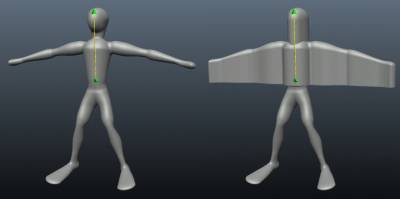
Αυτό εξετάζει τον υπάρχοντα όγκο ενός αντικειμένου και εξωθείται για να δημιουργήσει έναν νέο όγκο με βάση τη θέση του gizmo. Η περιοχή στη βάση (σφαίρα) του gizmo από την άκρη είναι η περιοχή που θα επηρεαστεί. Είναι εξαιρετικό για τη δημιουργία νομισμάτων και κοσμημάτων. Αυτό το εργαλείο δημιουργεί λεπτομέρειες “μισού ύψους” στη μία πλευρά του επιπέδου και στη συνέχεια εξωθεί αυτές τις λεπτομέρειες προς μια συγκεκριμένη κατεύθυνση. Κατευθυντική κωνικότητα ή σκουός στο άκρο βέλους του εργαλείου όταν ο συντελεστής είναι υψηλότερος ή χαμηλότερος από 1. Το άκρο της μπάλας του εργαλείου εξωθεί πάντα σημεία φόρμας υψηλού προφίλ στη θέση και την κατεύθυνση της μπάλας
Χειροκοπές Χρησιμοποιήστε αυτό το εργαλείο για να προετοιμάσετε ένα γλυπτό αντικείμενο για σκοπούς χύτευσης (όπου οι κάτω τομές είναι ανεπιθύμητες) και να αφαιρέσετε τις κάτω τομές για χύτευση.
Αυτό το εργαλείο αφαιρεί τις αόρατες περιοχές εάν κοιτάξετε το αντικείμενο από κάποια κατεύθυνση και την αντίθετη κατεύθυνση.
Το μοντέλο μπορεί να κοπεί με μηχάνημα CNC ή να καλουπωθεί εάν αφαιρέσετε τις υποκοπές. Πατήστε Εφαρμογή ή ENTER αφού επιλέξετε κατεύθυνση.
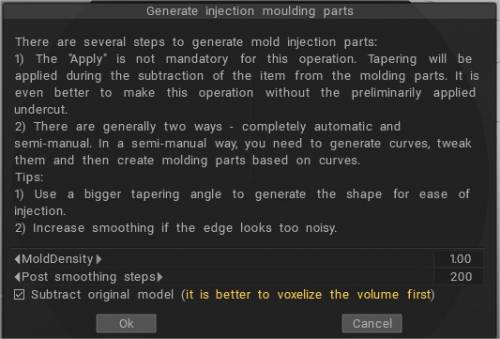
Η έκδοση 2022 έχει πολύ καλύτερα Undercuts και Moulding Tools (σε μια ειδική Extra Module)
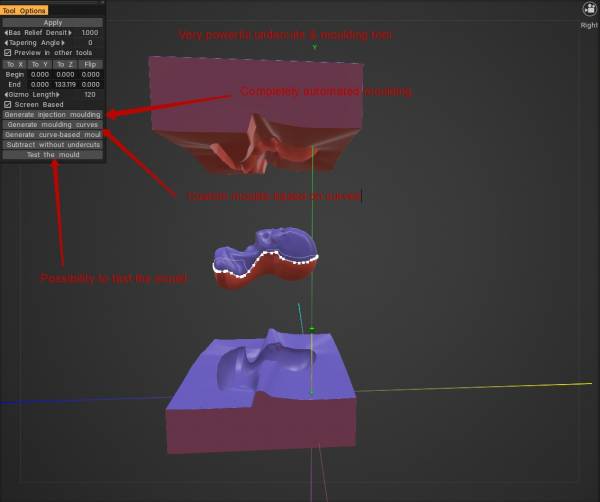
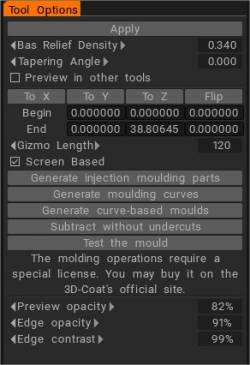
Φροντιστήριο
Γρήγορη συμβουλή: Χρήση του VoxHide ως εργαλείου κάλυψης : Αυτό το βίντεο δείχνει πώς το εργαλείο VoxHide μπορεί να χρησιμοποιηθεί ως εργαλείο κάλυψης στη θέση του Freeze Brush, το οποίο λειτουργεί μόνο σε λειτουργία Surface.
Αντιστροφή επιλογών Voxel με Εργαλείο αποκοπής και απόκρυψης : Αυτό το βίντεο είναι μια γρήγορη επίδειξη χρησιμοποιώντας το Εργαλείο αποκοπής και απόκρυψης. Δείχνει κυρίως τον τρόπο αντιστροφής μιας επιλογής χρησιμοποιώντας τα συσχετισμένα αλλά ελάχιστα γνωστά πλήκτρα πρόσβασης.
 Ελληνικά
Ελληνικά  English
English Українська
Українська Español
Español Deutsch
Deutsch Français
Français 日本語
日本語 Русский
Русский 한국어
한국어 Polski
Polski 中文 (中国)
中文 (中国) Português
Português Italiano
Italiano Suomi
Suomi Svenska
Svenska 中文 (台灣)
中文 (台灣) Dansk
Dansk Slovenčina
Slovenčina Türkçe
Türkçe Nederlands
Nederlands Magyar
Magyar ไทย
ไทย हिन्दी
हिन्दी Tiếng Việt
Tiếng Việt Lietuviškai
Lietuviškai Latviešu valoda
Latviešu valoda Eesti
Eesti Čeština
Čeština Română
Română Norsk Bokmål
Norsk Bokmål